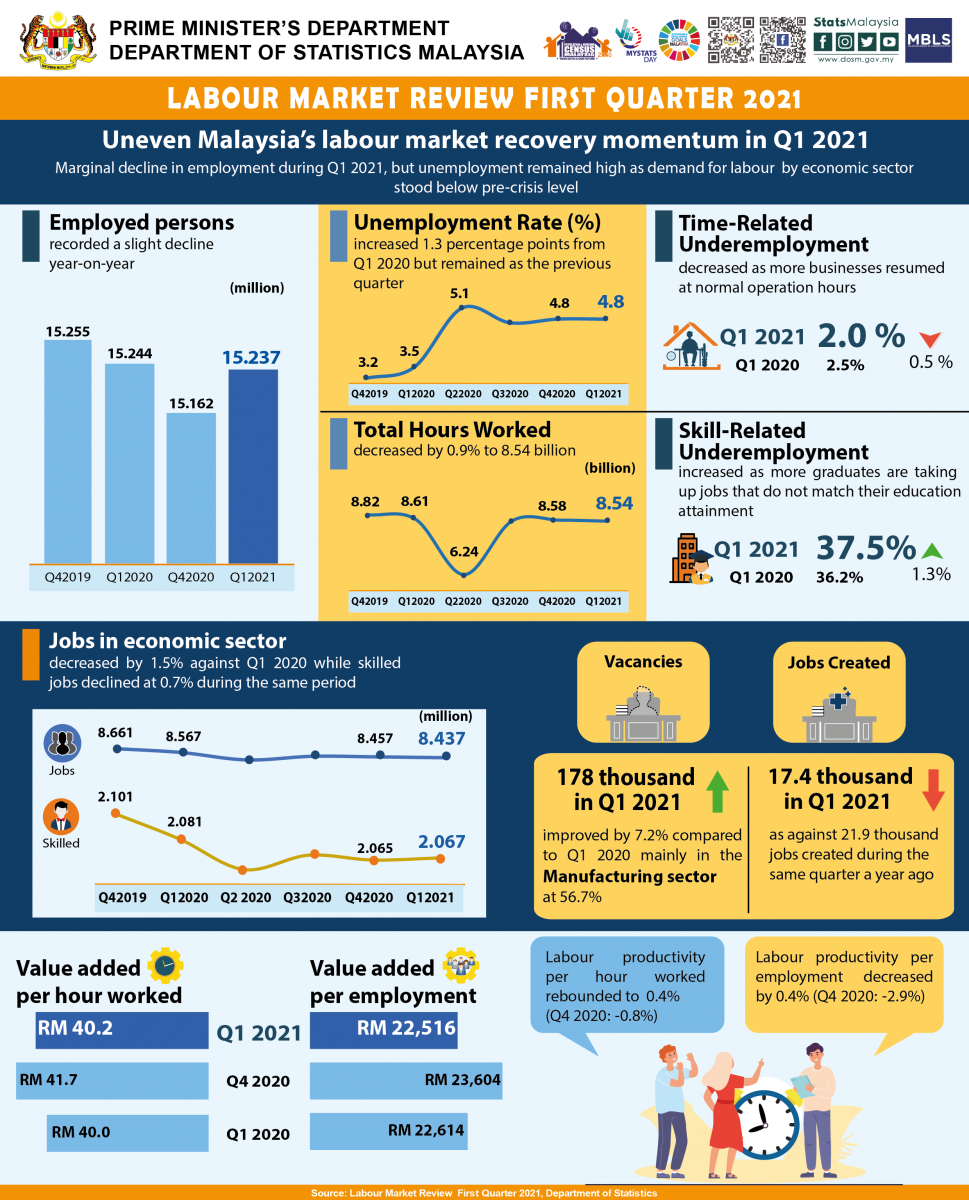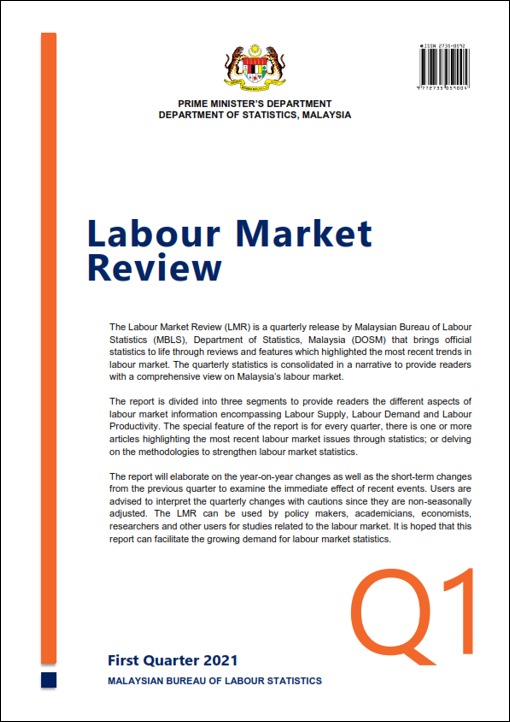Labour Market Review
- Home
- Statistics
- Labour Market
- Labour Market Information
- Labour Market Review
Labour Market Review, First Quarter 2021
Overview
Introduction
The Labour Market Review (LMR) is a quarterly release by Malaysian Bureau of Labour Statistics (MBLS), Department of Statistics, Malaysia (DOSM) that brings official statistics to life through reviews and features which highlighted the most recent trends in labour market. The quarterly statistics is consolidated in a narrative to provide readers with a comprehensive view on Malaysia’s labour market.
The report is divided into three segments to provide readers the different aspects of labour market information encompassing Labour Supply, Labour Demand and Labour Productivity. The special feature of the report is for every quarter, there is one or more article(s) highlighting the most recent labour market issues through statistics; or delving on the methodologies to strengthen labour market statistics.
The report will elaborate on the year-on-year changes as well as the short-term changes from the previous quarter to examine the immediate effect of recent events. Users are advised to interpret the quarterly changes with cautions since they are non-seasonally adjusted. The LMR can be used by policy makers, academicians, economists, researchers and other users for studies related to the labour market. It is hoped that this report can facilitate the growing demand for labour market statistics.
Key Reviews
- With adoption of targeted health containment measure in managing the public health crisis at the beginning of 2021, the labour market in Q1 2021 experienced modest recovery. Although slower declines were observed for most of the indicators which signalled optimist recovery momentum, the labour market scenario in Q1 2021 has not return to the way it was during pre-COVID time.
- In Q1 2021, the number of employed persons recorded a slight year-on-year decline by 7 thousand persons to 15.24 million persons with the employment-to-population ratio dropped 1.1 percentage points to 65.3 per cent. The unemployment rate stood at 4.8 per cent compared to 3.5 per cent in Q1 2020.
- Unlike Q1 2020, where MCO had prompted closures of most economic activities as well as national and interstate borders, Q1 2021 saw more states being in RMCO while several others were in CMCO. Along with this, most of the economic activities continued to operate in compliance with strict SOPs. Hence, the number of time-related underemployment fell 19.0 per cent (-72.2 thousand persons) as against Q1 2020 as more businesses resumed the normal operation hours by mid-February of 2021.
- The economic sector recorded a total of 8.437 million jobs in Q1 2021, dropped 1.5 per cent as compared to Q1 2020. The rate of filled jobs shrank by 0.2 percentage point to 97.9 per cent. On the contrary, the rate of vacancies increased to 2.1 per cent from 1.9 per cent in Q1 2020 to record 178 thousand vacancies. Besides, there were 17.4 thousand jobs created in the private sector during the quarter.
- As Malaysia’s GDP marginally decline 0.5 per cent in the first quarter of 2021 while total hours worked reduced by 0.9 per cent, labour productivity per hour worked increased 0.4 per cent. Meanwhile, labour productivity per employment declined 0.4 per cent.

- In weathering the difficult time, one of the fundamental issues that must be addressed is the livelihood of vulnerable workers. Government’s adoption of the three-pronged strategy in 2020 is part of the attempts to retain job, protect workers’ right and create job opportunities to help the people handled the tribulations brought by the COVID-19 pandemic. Efforts have been increased to expand the network of social protection to also include own-account workers and informal business owners.
- MCO 3.0 is implemented from 12 May to 7 June 2021 as daily infections continue to climb up to a new high. With these new sets of challenges, the unfavourable situation faced by businesses might prolonged in the second quarter of 2021. This may cause some interference to the labour market recovery momentum. With individuals and businesses exercising stringent adherence to standard operating procedures, it is hoped that MCO 3.0 will help to contain the daily infections to a manageable number and reduce the risk of infections to the vulnerable population. Subsequently, it may reduce daily number of deaths due to the pandemic. Additionally, as more people completed their vaccinations, this might offer some relief, increase business confidence and may restore the labour market dynamics in the country.

Download full LMR Q1 2021 publication here
The full publication of LMR Q1 2021 is also accessible and downloadable free of charge through the eStatistik application in DOSM web page, www.dosm.gov.my.
The Malaysia Population and Housing Census 2020 (Malaysia Census 2020) via online (e-Census) is being conducted nationwide until 30th June 2021. All Malaysian residents are urged to cooperate in realising the success of Malaysia Census 2020 to ensure that no one is left behind as your data is our future. Please visit the Malaysia Census 2020 portal at www.mycensus.gov.my or social media @MyCensus2020 for more info.
Released By:
DATO' SRI DR. MOHD UZIR MAHIDIN
CHIEF STATISTICIAN MALAYSIA
DEPARTMENT OF STATISTICS, MALAYSIA
![]() DrUzir_Mahidin
DrUzir_Mahidin ![]()
![]() Dr_Uzir
Dr_Uzir
21 May 2021
Contact person:
Mohd Yusrizal Ab Razak
Public Relation Officer
Strategic Communication and International Division
Department of Statistics, Malaysia
Tel : +603-8885 7942
Fax : +603-8888 9248
Email : yusrizal.razak[at]dosm.gov.my
Subscribe
Newsletter
Subscribe to our newsletter and stay updated
For interviews, press statement and clarification to the media, contact:
Baharudin Mohamad
Public Relation Officer
Email: baharudin[at]dosm.gov.my
Phone: 03 8090 4681
Not found what you looking for? Request data from us, through
Go to eStatistik
Email: data[at]dosm.gov.my
Phone: 03 8885 7128 (data request)










